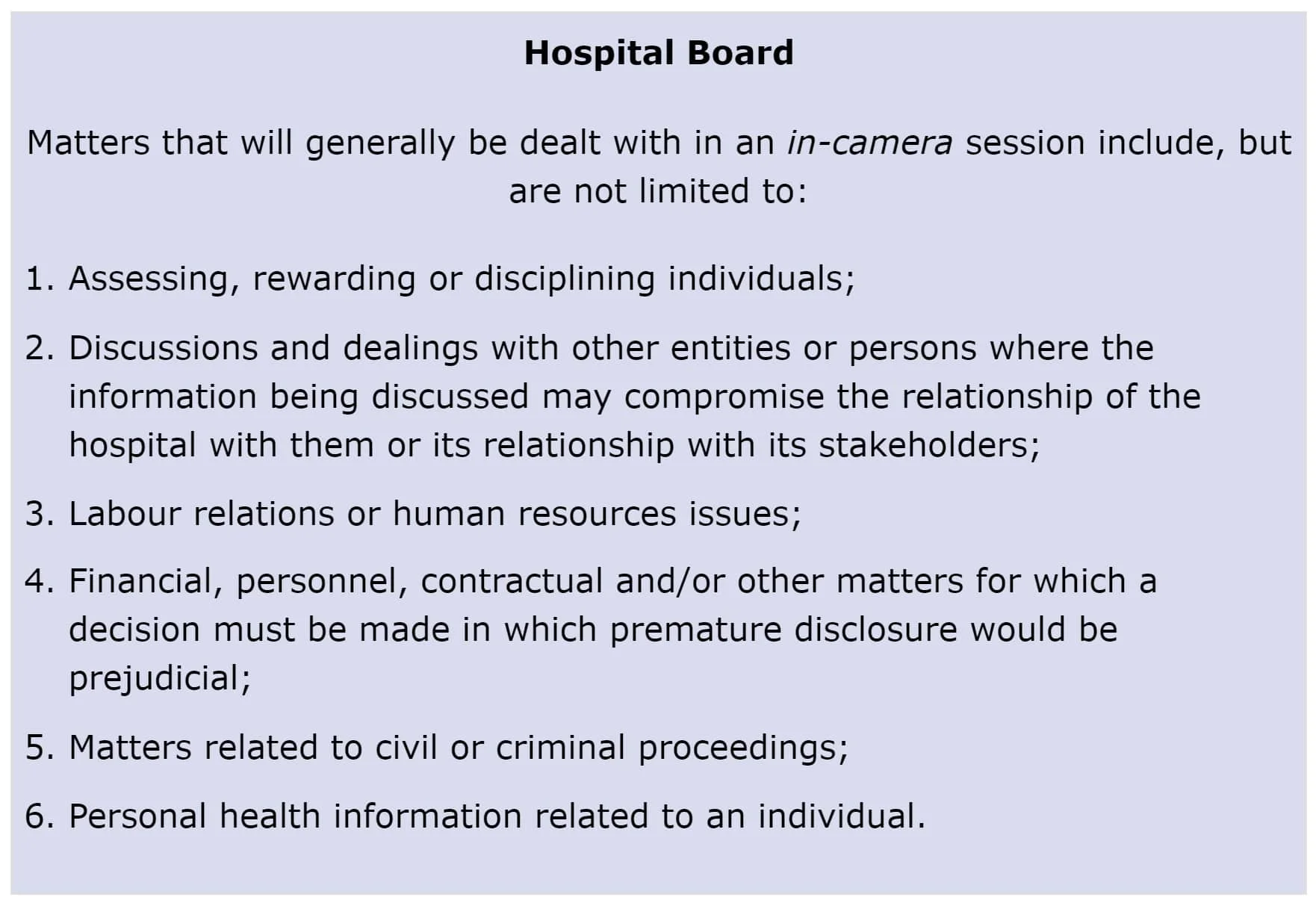What is an in camera session?
“In camera” is a Latin term which, in this context, can be understood to mean an "in private" session. It involves a confidential meeting, or a portion of a meeting, taking place with only Board members present. These meetings are sometimes called "Board only" sessions.
By its very definition, this disqualifies the Chief Executive, senior staff, consultants, commentators, observers, advisers, lawyers and auditors. However, allowances can be made to include any parties the Board requires for the specific issues being discussed. For example, the Chief Financial Officer may need to present a report during a discussion surrounding a potential merger.
These meetings are by the Board and for the Board, and only board members are entitled to attend. This allows for a higher degree of self-management and oversight.
Without the observation of the Chief Executive, in camera sessions allow board members to discuss and relate to one another as equal peers on the leadership team. This can encourage greater honesty among board members and strengthen the Board’s independence from the chief executive.
An in camera session can be a regularly scheduled event at the beginning or end of a Board meeting, it can be called by the Chairperson or by formal motion through a majority vote from the Board. Typically, it is planned ahead of time with the knowledge of the Chief Executive. These meetings are designed to handle sensitive issues that cannot be discussed publicly. In essence, an in camera session serves three core functions:
(1) it assures confidentiality;
(2) it creates a mechanism for board independence and oversight; and
(3) it enhances relationships among board members and the Chief Executive
What happens when an in camera session is called?
The idea of a private conversation run exclusively for board members may appear to run contrary to the expected principles of transparency and openness ─ especially when you consider the value of a constructive partnership between the Chief Executive and the Board.
But there are instances where a formal framework like this can be a strategic tool.
When an in camera session is called a few things may occur:
(1) Anyone who is not a member of the Board is required to leave. This would include the CEO. In a nonprofit context, the persons most likely to be excused are the CEO, other senior staff members, observers etc. In municipal Government, those excused may include members of the public or media.
(2) The recorded minutes or any documents distributed during this meeting are not made public (and are not attached to regular Board meetings). The minutes are only available to those present in the meeting. If a decision is made during the in camera session, that decision should be recorded in the Board minutes as a formal record, as required by law.
Free White Paper: 10 Powerful Questions for Board Members & Business Owners
New questions equal new answers for your organization. Take these 10 questions and begin using them at Board and staff meetings to radically alter the trajectory of a discussion into new and fertile ground.
Why would you need to use an in camera session?
In camera sessions must be used judiciously. Ask yourself if the motivation for a closed or private deliberation is tied to the need for confidentiality or secrecy? These sessions exist to serve particular purposes that the Board should clearly define and follow.
Good Board governance requires confidentiality to protect individuals and sometimes the organization. Secrecy, on the other hand, is seen as a misuse of trust and can damage or undermine authority.
It’s important to never abuse an in camera session or use it unnecessarily. One way to avoid arousing suspicion in the event you need an in camera session is by using this type of mechanism before an explicit need is made apparent. Take a portion of every Board meeting and close it off to non-board members.
In the event of an actual crisis, all board members should be comfortable with their responsibilities, which would reduce suspicion and anxiety especially amongst those excluded from the proceedings.
Some scenarios which may require special treatment:
Positions to be taken during collective bargaining
Operational transitions (e.g. undertaking a strategic alliance)
Succession planning
Senior staff performance
Personnel items such as salaries
The evaluation of the Executive Director or CEO compensation
Organizational failures (e.g. filing for bankruptcy)
The handling of conflict of interest situations
Discussions of a lawsuit currently aimed at the organization
Challenging a decision made by the Chief Executive away from staff (to preserve his/her authority)
Time-sensitive opportunities that can’t yet be made public
Take this example of the required criteria to call an in camera session, taken from a public hospital board:
Image via Nonprofit Quarterly
When to run an in camera session with Board Alone
image via https://www.boardsource.org/eweb/
If the CEO becomes concerned: 5 ways to maintain their trust
Regularly hold in camera sessions: diffuse the notion they are only convened to deal with matters involving the CEO or an imminent crisis.
Set an agenda prior to the board meeting.
Invite the CEO to join part of the session.
Keep to the agenda and ensure the Board chair stops any gossip from developing.
When/if appropriate, let the CEO know a summary of what was discussed.
When handled correctly, an in camera session can be a space to pursue sensitive issues in a safe environment. The Chair's role is to ensure that the meeting never descends into petty gossip. This is crucial to ensure the confidence of the CEO is maintained and a culture of secrecy does not develop.
In the absence of trust, invoking an in camera session in order for the Board to have a frank discussion, likely serves to legitimize organization sanctioned secrecy. The Board and CEO need to cultivate a governance culture of honest dialogue, debate and respectful listening.
Do you regularly hold in camera sessions? If so, what works for you? Leave your thoughts in the comments below.








